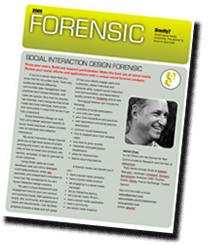At this point in time the technical challenges are not simple. So the scenario I am exploring here is conjectural. But worth speculating on, if for no other reason than the probability that sharing across activity streams seems in ways inevitable. Note that the points I raise are not criticisms of the effort, but observations intended to spark discussion.
Let's contemplate the implications of conversation across activity streams. Implications involve not only the facilitation of communication between networks, but other factors too, including redundancy, notifications, noise, spam, context, and quite possibly, an increased burden on users to meet conversational expectations. Each of these is a matter of social interaction design — user experience of networked talk and relationships among users maintained in social media tools and applications. I will address these in no particular order.
For simplicity's sake, let's just assume that a single user is named in a single post authored in Buzz, and avoid contemplating multiple username mentions.
Redundancy
Sharing @mentions across networks would increase message redundancy. Our sample message would appear in twitter as an @reply. If it were longer than 140 characters, it would be truncated to fit twitter's format. Alternatively, it might appear as a system notification. For example: "@username You were mentioned by @googleprofilename in Buzz http://link". Or: "I liked what @username said" by@googleprofilename from Buzz. Formatting issues would of course have to be addressed.
Redundancy would accrue according to the number of participating networks our @username belonged to. Each would reprint the Buzz post mention. Our @username would see duplicate notifications in each network, and potentially would receive email notifications of these messages from some networks also. The result: a lot of additional notifications proliferating from that one Buzz mention.
Noise
This notification redundancy, which some might find useful, would be noise to others. My email account is already a bucketful of notifications. Which is ironic insofar as email is already meant for communication. That so much of this communication notifies me of communication gets to be noisy.
Audiences
Each network is also an audience. Users are invested in their audiences, in terms of status; posting habits; engagement with a private, social, or public presence; relationships and the expectations those entail; attention paid to message flow, awareness of audience members (services have different social uses); and more.
In other words, each of us turns to an audience for certain kinds of engagement and according to our individual habits of use. For example, Buzz for peer conversation and discussion, twitter for maintaining a profile, Facebook for friends, and so on (blogs and commenting included). Because these audiences are different and have different meanings for us, the appearance of @username messages originating in one network on other networks may lead to at least two kinds of ambiguity.
The first kind of ambiguity pertains to the appearance of the message. Do I want to see it here? Does it transgress boundaries I might perceive between each network, and more personally, to how I see myself within each one? I may, for example, engage in different kinds of conversation within each network, and prefer to have those boundaries constrain my obligations to participation in each.
The second kind of ambiguity pertains to my responses. There are two distinct issues here.
- The first concerns effectiveness. Which network is best for me to respond in, given my understanding of an author's habits of use. I may want to respond in the network preferred by that user. That's where my response is most likely to receive attention. (Many of us do this already between twitter and Facebook, knowing our friends' and colleagues' engagement styles with each.)
- The second concerns my own preferences for being seen responding to others. In contrast to effectiveness of communication, this has to do with self-perception. I may see myself differently in each network, and am aware of how I (believe) I am seen by others. This reflects on my activity and is taken into account (unconsciously or consciously) as I reply or mention others within each "space" or social context.
Not only are audiences a reflection on our self-image and self-perception within a network, they are constructed differently, too. This follows from the manner in which specific features have been deployed within the network, as well as its population, social practices, and cultures. Audiences have a sociality and are unique to each service. We can even observe tacit norms of use and conventions emerging and then passing in each network. These social dynamics affect use of @replies and @mentions. For example, the twitter practice of using multiple @names to loop users into an exchange, is not a convention (yet?) in Buzz.
A great number of these particular practices could be upset by sharing @names across streams. Others might become confusing, if, for example, @names proliferated so excessively that conventions simply broke down as a result of degradation.
Context
All talk is contextual. It establishes and creates context of its own, as meaning provided by what participants say. It refers to more than what is actually said, too, and so has social context, context supplied by references, connotations, and social significations. It has context according to who participates (including those individuals' reputations, credibility, authority etc). Increasingly, there is context supplied by location, and the different axes of relevance along which mobile checkins and posts are useful. And, of course, context obtained from the social media tool or service in which the talk appears (this informs our understanding of what participants are doing by talking.)
Contextuality will be disrupted by the sharing of @names across social networks. Not only is the originally-authored post reproduced in a new context, but any follow-on messaging will re-contextualize it in ways just described.
This disruption of context may have significant consequences for shared stream mentions simply because context provides so much of the meaning not of the message but around it also. Its references, history, and authors — these implicit cues are invaluable to interpreting (reading) what's being said and what's going on. (Talk in social media is more than what's communicated as content, but is a social activity.)
Loss of original context and re-contextualization within new streams and networks creates confusion. Confusion concerning what a message means, confusion regarding what to do with it, and now confusion about where to continue the conversation. And distributed and disaggregated messaging can mean that each of these steps in the conversational "chain" only further proliferates the branching of the series. Multiple series could conceivably take shape within new network streams. Which brings us to the next problem: expectations.
Expectations and obligations
There is no meta-data supplied with the activity post that indicates the author's desire for responses and replies. We can do this in face to face communication just by looking at each other. But artifacted (text) messages lack this intentional cue.
It is up to users to choose to respond to a message, and with shared stream posts it will be up to users to make choices in more places and in conditions of greater ambiguity. For some, I suspect this will be too demanding. Users who think about what it means to be seen replying to others, and those who might dwell on silences and may wonder if they are being ignored, will suffer the most.
The author of the original post may find the additional demands of tracking and monitoring posts proliferating across networks to be too much. Those mentioned in the post may want for a clear sense of what's expected, if anything, by ways of a reply (and where).
Loss of context robs the original post of some of the implicit and tacit expectation it solicits for responses by audiences. Where users pay attention to and are engaged by this, their perceived expectations and obligations of reciprocity and mutual recognition fail as a means of orienting their behavior.
Conclusions
I have not exhausted the implications of cross-references in activity streams. Multiple @username mentions, message length (Buzz and Facebook posts are not limited to 140 characters), commenting permitted in Buzz and Facebook but not in twitter, realtime search, and geolocation are but some of the practices that would further complicate matters.
But insofar as the technical effort to resolve identity according to some shared protocol, enabling decentralized posting within separate networks to become cross-referential, presents a clear opportunity for engineering success, social and practical ramifications are worth considering. I have only scratched the surface here. So I look forward to where this goes.
The efforts mentioned were kicked off in this post on Buzz:
Envisioning decentralized @replies and notifications with WebFinger.
Related:
- Breaking down the Gbuzz
- If twitter is micro-blogging, is Buzz micro-commentary?
- Google Buzz v twitter: more on micro-commentary
- May I have your buzz, please?
Labels: buzz, status updates, sxd, twitter




Comments: :
blog comments powered by Disqus
<< Home